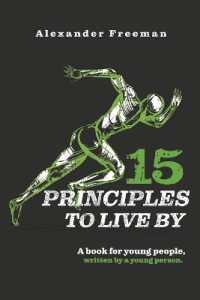- ホーム
- > 洋書
- > 英文書
- > Cinema / Film
Full Description
From Destination Tokyo (1943) to The Battle of the Villa Fiorita (1965), Delmer Daves was responsible for a unique body of work, but few filmmakers have been as critically overlooked in existing scholarly literature. Often regarded as an embodiment of the self-effacing craftsmanship of classical and post-War Hollywood, films such as Broken Arrow (1950) and 3:10 to Yuma (1957) reveal a filmmaker concerned with style as much as sociocultural significance. As the first comprehensive study of Daves's career, this collection of essays seeks to deepen our understanding of his work, and also to problematize existing conceptions of him as a competent, conventional and even naïve studio man.
Contents
Introduction: No One Would Know It Was Mine: Delmer Daves, Modest Auteur; Chapter One: Don't Be Too Quick to Dismiss Them: Authorship and the Westerns of Delmer Daves, Andrew Patrick Nelson; Chapter Two: Trying to Ameliorate the Within: Delmer Daves's Westerns from the 1950s, John White; Chapter Three: Bent, or Lifted Out By Its Roots: Daves' Broken Arrow and Drum Beat as Narratives of Conditional Sympathy, Józef Jaskulski; Chapter Four: This Room is My Castle of Quiet: The Collaborations of Delmer Daves and Glenn Ford, Adrian Danks; Chapter Five: Delmar Daves, Authenticity, and Auteur Elements: Celebrating the Ordinary in Cowboy , Sue Matheson; Chapter Six: Home and the Range : Spencer's Mountain as Revisionist Family Melodrama, Joseph Pomp; Chapter Seven: Delmer Daves' 3:10 to Yuma: Aesthetics, Reception and Cultural Significance, Fran Pheasant-Kelly; Chapter Eight: Changing Societies: The Red House, The Hanging Tree, Spencer's Mountain and Postwar America, Fernando Gabriel Pagnoni Berns; Chapter Nine: Partial Rehabilitation: Task Force and the Case of Billy Mitchell, Andrew Howe; Chapter Ten: "This is where he brought me: 10,000 acres of nothing!" The Femme Fatale and other Film Noir Tropes in Delmer Daves' Jubal, Matthew Carter







